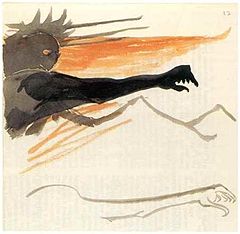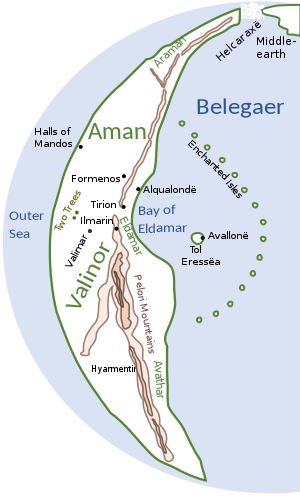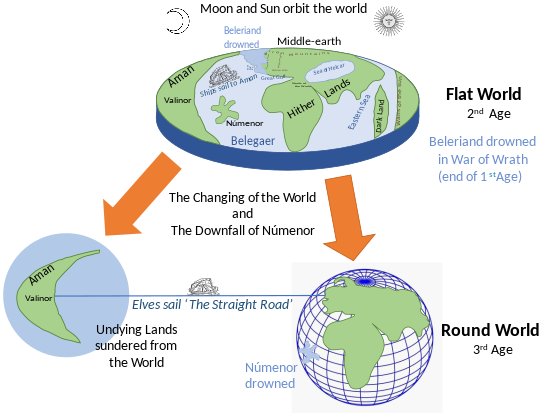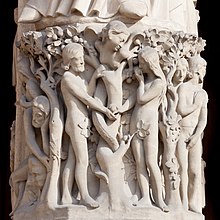Ungoliant is a fictional character in J. R. R. Tolkien's legendarium, described as an evil spirit in the form of a giant spider. Her name means "dark spider" in Sindarin. She is mentioned briefly in The Lord of the Rings, and plays a supporting role in The Silmarillion, enabling the Dark Lord Melkor to destroy the Two Trees of Valinor, darkening the world.
In the works of J. R. R. Tolkien, the Noldor are a kindred of Elves who migrate west to the blessed realm of Valinor from the continent of Middle-earth, splitting from other groups of Elves as they went. They then settle in the coastal region of Eldamar. The Dark Lord Morgoth murders their first leader, Finwë. The majority of the Noldor, led by Finwë's eldest son Fëanor, then return to Beleriand in the northwest of Middle-earth. This makes them the only group to return and then play a major role in Middle-earth's history; much of The Silmarillion is about their actions. They are the second clan of the Elves in both order and size, the other clans being the Vanyar and the Teleri.
Finwë and Míriel are fictional characters from J. R. R. Tolkien's legendarium. Finwë is the first King of the Noldor Elves; he leads his people on the journey from Middle-earth to Valinor in the blessed realm of Aman. His first wife is Míriel, who, uniquely among immortal Elves, dies while giving birth to their only child Fëanor, creator of the Silmarils; her spirit later serves the godlike Vala queen Vairë. Finwë is the first person to be murdered in Valinor: he is killed by the Dark Lord Morgoth, who is intent on stealing the Silmarils. The event sets off the Flight of the Noldor from Valinor back to Beleriand in Middle-earth, and its disastrous consequences.

Fëanor is a fictional character in J. R. R. Tolkien's The Silmarillion. He creates the Tengwar script, the palantír seeing-stones, and the three Silmarils, the skilfully-forged jewels that give the book their name and theme, triggering division and destruction. He is the eldest son of Finwë, the King of the Noldor Elves, and his first wife Míriel.

Fingolfin is a character in J. R. R. Tolkien's legendarium, appearing in The Silmarillion. He was the son of Finwë, High King of the Noldor. He was threatened by his half-brother Fëanor, who held him in contempt for not being a pure-bred Noldor. Even so, when Fëanor stole ships and left Aman, Fingolfin chose to follow him back to Middle-earth, taking the dangerous route over the ice of the Helcaraxë. On arrival, he challenged the Dark Lord Morgoth at the gates of his fortress, Angband, but Morgoth stayed inside. When his son Fingon rescued Maedhros, son of Fëanor, Maedhros gratefully renounced his claim to kingship, and Fingolfin became High King of the Noldor. He was victorious at the battle of Dagor Aglareb, and there was peace for some 400 years until Morgoth broke out and destroyed Beleriand in the Dagor Bragollach. Fingolfin, receiving false news, rode alone to Angband and challenged Morgoth to single combat. He wounded Morgoth several times, but grew weary and was killed by the immortal Vala.
In J. R. R. Tolkien's legendarium, the Elves or Quendi are a sundered (divided) people. They awoke at Cuiviénen on the continent of Middle-earth, where they were divided into three tribes: Minyar, Tatyar and Nelyar. After some time, they were summoned by Oromë to live with the Valar in Valinor, on Aman. That summoning and the Great Journey that followed split the Elves into two main groups, which were never fully reunited.

Morgoth's Ring (1993) is the tenth volume of Christopher Tolkien's 12-volume series The History of Middle-earth in which he analyses the unpublished manuscripts of his father J. R. R. Tolkien.

In J. R. R. Tolkien's legendarium, the history of Arda, also called the history of Middle-earth, began when the Ainur entered Arda, following the creation events in the Ainulindalë and long ages of labour throughout Eä, the fictional universe. Time from that point was measured using Valian Years, though the subsequent history of Arda was divided into three time periods using different years, known as the Years of the Lamps, the Years of the Trees, and the Years of the Sun. A separate, overlapping chronology divides the history into 'Ages of the Children of Ilúvatar'. The first such Age began with the Awakening of the Elves during the Years of the Trees and continued for the first six centuries of the Years of the Sun. All the subsequent Ages took place during the Years of the Sun. Most Middle-earth stories take place in the first three Ages of the Children of Ilúvatar.
In J. R. R. Tolkien's legendarium, the Two Trees of Valinor are Telperion and Laurelin, the Silver Tree and the Gold Tree, which bring light to Valinor, a paradisiacal realm where angelic beings live. The Two Trees are of enormous stature, and exude dew that is a pure and magical light in liquid form. The craftsman Elf Fëanor makes the unrivalled jewels, the Silmarils, with their light. The Two Trees are destroyed by the evil beings Ungoliant and Melkor, but their last flower and fruit are made into the Moon and the Sun. Melkor, now known as Morgoth, steals the Silmarils, provoking the disastrous War of the Jewels. Descendants of Telperion survive, growing in Númenor and, after its destruction, in Gondor; in both cases the trees are symbolic of those kingdoms. For many years while Gondor has no King, the White Tree of Gondor stands dead in the citadel of Minas Tirith. When Aragorn restores the line of Kings to Gondor, he finds a sapling descended from Telperion and plants it in his citadel.
The fictional races and peoples that appear in J. R. R. Tolkien's fantasy world of Middle-earth include the seven listed in Appendix F of The Lord of the Rings: Elves, Men, Dwarves, Hobbits, Ents, Orcs and Trolls, as well as spirits such as the Valar and Maiar. Other beings of Middle-earth are of unclear nature such as Tom Bombadil and his wife Goldberry.
The cosmology of J. R. R. Tolkien's legendarium combines aspects of Christian theology and metaphysics with pre-modern cosmological concepts in the flat Earth paradigm, along with the modern spherical Earth view of the Solar System.
The Ainur (singular: Ainu) are the immortal spirits existing before the Creation in J. R. R. Tolkien's fictional universe. These were the first beings made of the thought of Eru Ilúvatar. They were able to sing such beautiful music that the world was created from it.
Númenor, also called Elenna-nórë or Westernesse, is a fictional place in J. R. R. Tolkien's writings. It was the kingdom occupying a large island to the west of Middle-earth, the main setting of Tolkien's writings, and was the greatest civilization of Men. However, after centuries of prosperity many of the inhabitants ceased to worship the One God, Eru Ilúvatar, and rebelled against the Valar, resulting in the destruction of the island and the death of most of its people. Tolkien intended Númenor to allude to the legendary Atlantis. Commentators have noted that the destruction of Númenor echoes the Biblical stories of the fall of man and the destruction of Sodom and Gomorrah, and John Milton's Paradise Lost.
The Maiar are a fictional class of beings from J. R. R. Tolkien's high fantasy legendarium. Supernatural and angelic, they are "lesser Ainur" who entered the cosmos of Eä in the beginning of time. The name Maiar is in the Quenya tongue from the Elvish root maya- "excellent, admirable".
Morgoth Bauglir is a character, one of the godlike Valar, from Tolkien's legendarium. He is the primary antagonist of The Silmarillion, The Children of Húrin, Beren and Lúthien, and The Fall of Gondolin.

Sauron is the title character and the primary antagonist, through the forging of the One Ring, of J. R. R. Tolkien's The Lord of the Rings, where he rules the land of Mordor and has the ambition of ruling the whole of Middle-earth. In the same work, he is identified as the "Necromancer" of Tolkien's earlier novel The Hobbit. The Silmarillion describes him as the chief lieutenant of the first Dark Lord, Morgoth. Tolkien noted that the Ainur, the "angelic" powers of his constructed myth, "were capable of many degrees of error and failing", but by far the worst was "the absolute Satanic rebellion and evil of Morgoth and his satellite Sauron". Sauron appears most often as "the Eye", as if disembodied.
The Silmarils are three fictional brilliant jewels in J. R. R. Tolkien's legendarium, made by the Elf Fëanor, capturing the unmarred light of the Two Trees of Valinor. The Silmarils play a central role in Tolkien's book The Silmarillion, which tells of the creation of Eä and the beginning of Elves, Dwarves and Men.
The Valar are characters in J. R. R. Tolkien's legendarium. They are "angelic powers" or "gods" subordinate to the one God. The Ainulindalë describes how some of the Ainur choose to enter the World (Arda) to complete its material development after its form is determined by the Music of the Ainur. The mightiest of these are called the Valar, or "the Powers of the World", and the others are known as the Maiar.

The Silmarillion is a collection of myths and stories in varying styles by the English writer J. R. R. Tolkien. It was edited and published posthumously by his son Christopher Tolkien in 1977, assisted by Guy Gavriel Kay, who became a fantasy author. It tells of Eä, a fictional universe that includes the Blessed Realm of Valinor, the ill-fated region of Beleriand, the island of Númenor, and the continent of Middle-earth, where Tolkien's most popular works—The Hobbit and The Lord of the Rings—are set. After the success of The Hobbit, Tolkien's publisher, Stanley Unwin, requested a sequel, and Tolkien offered a draft of the writings that would later become The Silmarillion. Unwin rejected this proposal, calling the draft obscure and "too Celtic", so Tolkien began working on a new story that eventually became The Lord of the Rings.
J. R. R. Tolkien built a process of decline and fall in Middle-earth into both The Silmarillion and The Lord of the Rings.











